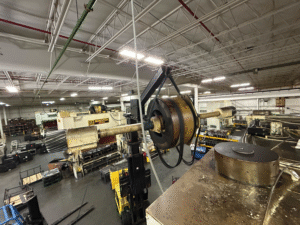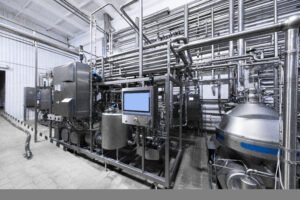In the rapidly evolving landscape of industrial operations, efficient storage solutions play a pivotal role in maintaining a competitive edge. Modern industrial storage facilities are tasked with not only accommodating large volumes of products but also ensuring seamless accessibility, streamlined processes, and cost-effective operations. This article delves into key strategies that industries can adopt to optimize efficiency within their storage facilities, ultimately enhancing productivity, reducing waste, and maximizing profits.
The Foundation of Efficient Storage: Space Management
Effective space management is the cornerstone of any efficient industrial storage facility. As available space becomes more valuable, adopting intelligent space allocation and utilization strategies is crucial. Peter Drucker’s words emphasize this: *”Do what you do best and outsource the rest.”* In other words, focus on your core business activities and let optimized storage solutions handle the rest.
Utilizing Vertical Space with High-Density Storage Systems
To make the most of available space, industrial storage facilities are increasingly turning to high-density storage systems. These systems, such as pallet racking, automated storage and retrieval systems (AS/RS), and mezzanine platforms, maximize vertical space utilization. By stacking goods higher and efficiently using vertical dimensions, businesses can significantly increase their storage capacities without expanding their physical footprint.
The renowned industrial engineer and management consultant W. Edwards Deming once said, “Innovation comes from the producer – not from the customer.” The innovation of high-density storage systems exemplifies this principle, as businesses take the initiative to reimagine their storage setups and make efficient use of vertical space.
Just-In-Time Inventory Management
Implementing a just-in-time (JIT) inventory management system is another strategy to optimize space and efficiency within industrial storage facilities. By ordering and storing materials only when needed for production, businesses can reduce the need for extensive storage space and excess inventory. This approach minimizes waste and frees up space for value-added activities. As the Japanese industrialist Taiichi Ohno famously stated, “Inventory is evil.” JIT aims to eliminate this evil, leading to streamlined operations and reduced storage costs.
Automation and Technology: Transforming Storage Operations
In the digital age, automation and technology have become integral components of optimizing efficiency in industrial storage facilities. These advancements not only enhance accuracy and speed but also enable real-time monitoring and data-driven decision-making.
Robotics in Warehousing
The integration of robotics in warehousing and storage facilities is revolutionizing the way goods are stored and retrieved. Robots equipped with computer vision, AI algorithms, and advanced gripping mechanisms can efficiently move, sort, and organize products within the facility. As Amazon’s Chief Technologist for Robotics, Tye Brady, put it, “It’s not about humans versus robots; it’s about humans and robots.” Collaborative efforts between human workers and robots can achieve unprecedented efficiency levels in storage operations.
Data Analytics for Predictive Insights
Incorporating data analytics into storage facility operations provides a deeper understanding of inventory patterns, demand fluctuations, and optimal storage layouts. With the help of predictive analytics, businesses can anticipate demand, optimize inventory levels, and plan storage strategies accordingly. As renowned statistician W. Edwards Deming said, “In God we trust; all others bring data.” Utilizing data-driven insights ensures informed decision-making and minimizes wasteful storage practices.
Sustainability and Eco-Friendly Storage Solutions
Efficiency in industrial storage facilities goes hand in hand with sustainability. Adopting eco-friendly storage solutions not only reduces the environmental impact but can also lead to cost savings in the long run.
Green Storage Construction and Design
Green construction practices, such as utilizing renewable materials, optimizing natural lighting, and integrating energy-efficient systems, are becoming standard in modern industrial storage facility design. These practices not only reduce the facility’s carbon footprint but also create a healthier working environment for employees. As architect Frank Lloyd Wright stated, “Study nature, love nature, stay close to nature. It will never fail you.” Embracing nature-inspired designs enhances sustainability and efficiency.
Energy-Efficient Warehouse Operations
Minimizing energy consumption within storage facilities is a critical aspect of sustainability. Implementing energy-efficient lighting, heating, cooling, and ventilation systems can significantly reduce operational costs and contribute to a greener footprint. In the words of environmentalist and author Wendell Berry, “The Earth is what we all have in common.” Adopting energy-efficient practices is a shared responsibility for a sustainable future.
Continuous Improvement: The Path to Optimal Efficiency
Efficiency is not a one-time achievement but an ongoing journey. Continuously improving storage strategies and adapting to changing industry dynamics is key to maintaining optimal efficiency.
Kaizen Philosophy for Lean Storage
The Kaizen philosophy, rooted in Japanese management practices, emphasizes continuous improvement in all aspects of an organization. Applying Kaizen principles to storage facilities involves regularly reassessing storage methods, layouts, and processes to identify areas for enhancement. As the founder of Toyota, Sakichi Toyoda, once stated, “The key to the Toyota Way and what makes Toyota stand out is not any of the individual elements… But what is important is having all the elements together as a system. It must be practiced every day in a very consistent manner.” Consistent improvement efforts lead to sustained efficiency gains.
Agile Adaptation to Industry Changes
Industries are subject to frequent changes in demand, technology, and regulations. Adapting storage strategies to these changes is crucial for maintaining efficiency. The agile methodology, widely used in software development, emphasizes flexibility and responsiveness to evolving requirements. Applied to storage facilities, this approach involves quickly adjusting storage layouts, systems, and processes in response to market shifts. As software engineer Kent Beck, one of the authors of the Agile Manifesto, noted, “I’m not a great programmer; I’m just a good programmer with great habits.” Developing adaptable habits ensures efficient responses to changing circumstances.
Conclusion
Efficiency is the driving force behind successful industrial storage facilities. By focusing on space management, embracing automation and technology, prioritizing sustainability, and committing to continuous improvement, businesses can create storage solutions that optimize operations, reduce waste, and enhance their competitive advantage. As efficiency guru Peter Drucker wisely said, “Efficiency is doing things right; effectiveness is doing the right things.” By implementing the right strategies, modern industrial storage facilities can achieve both efficiency and effectiveness, propelling them toward greater success in the dynamic industrial landscape.


















